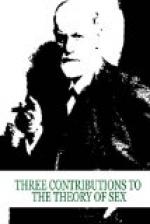Accidental Experiences.—All other influences lose in significance when compared with the sexual discharges, shifts of repressions, and sublimations; the inner determinations for the last two processes are totally unknown to us. He who includes repressions and sublimations among constitutional predispositions, and considers them as the living manifestations of the same, has surely the right to maintain that the final structure of the sexual life is above all the result of the congenital constitution. No intelligent person, however, will dispute that in such a cooeperation of factors there is also room for the modifying influences of occasional factors derived from experience in childhood and later on.
It is not easy to estimate the effectiveness of the constitutional and of the occasional factors in their relation to each other. Theory is always inclined to overestimate the first while therapeutic practice renders prominent the significance of the latter. By no means should it be forgotten that between the two there exists a relation of cooeperation and not of exclusion. The constitutional factor must wait for experiences which bring it to the surface, while the occasional needs the support of the constitutional factor in order to become effective. For the majority of cases one can imagine a so-called “etiological group” in which the declining intensities of one factor become balanced by the rise in the others, but there is no reason to deny the existence of extremes at the ends of the group.
It would be still more in harmony with psychoanalytic investigation if the experiences of early childhood would get a place of preference among the occasional factors. The one etiological group then becomes split up into two which may be designated as the dispositional and the definitive groups. Constitution and occasional infantile experiences are just as cooeperative in the first as disposition and later traumatic experiences in the second group. All the factors which injure the sexual development show their effect in that they produce a regression, or a return to a former phase of development.
We may now continue with our task of enumerating the factors which have become known to us as influential for the sexual development, whether they be active forces or merely manifestations of the same.
Prematurity.—Such a factor is the spontaneous sexual prematurity which can be definitely demonstrated at least in the etiology of the neuroses, though in itself it is as little adequate for causation as the other factors. It manifests itself in a breaking through, shortening, or suspending of the infantile latency period and becomes a cause of disturbances inasmuch as it provokes sexual manifestations which, either on account of the unready state of the sexual inhibitions or because of the undeveloped state of the genital system, can only carry along the character of perversions. These tendencies to perversion




